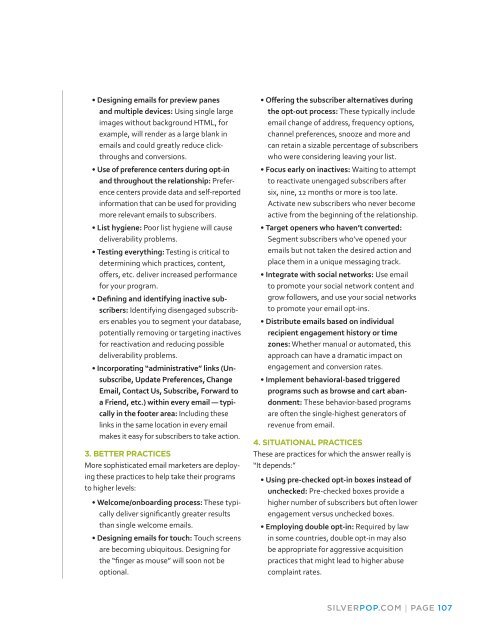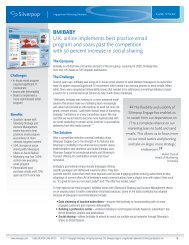eBook - Silverpop
eBook - Silverpop
eBook - Silverpop
Create successful ePaper yourself
Turn your PDF publications into a flip-book with our unique Google optimized e-Paper software.
• Designing emails for preview panes<br />
and multiple devices: Using single large<br />
images without background HTML, for<br />
example, will render as a large blank in<br />
emails and could greatly reduce clickthroughs<br />
and conversions.<br />
• Use of preference centers during opt-in<br />
and throughout the relationship: Preference<br />
centers provide data and self-reported<br />
information that can be used for providing<br />
more relevant emails to subscribers.<br />
• List hygiene: Poor list hygiene will cause<br />
deliverability problems.<br />
• Testing everything: Testing is critical to<br />
determining which practices, content,<br />
offers, etc. deliver increased performance<br />
for your program.<br />
• Defining and identifying inactive subscribers:<br />
Identifying disengaged subscribers<br />
enables you to segment your database,<br />
potentially removing or targeting inactives<br />
for reactivation and reducing possible<br />
deliverability problems.<br />
• Incorporating “administrative” links (Unsubscribe,<br />
Update Preferences, Change<br />
Email, Contact Us, Subscribe, Forward to<br />
a Friend, etc.) within every email — typically<br />
in the footer area: Including these<br />
links in the same location in every email<br />
makes it easy for subscribers to take action.<br />
3. BETTER PRACTICES<br />
More sophisticated email marketers are deploying<br />
these practices to help take their programs<br />
to higher levels:<br />
• Welcome/onboarding process: These typically<br />
deliver significantly greater results<br />
than single welcome emails.<br />
• Designing emails for touch: Touch screens<br />
are becoming ubiquitous. Designing for<br />
the “finger as mouse” will soon not be<br />
optional.<br />
• Offering the subscriber alternatives during<br />
the opt-out process: These typically include<br />
email change of address, frequency options,<br />
channel preferences, snooze and more and<br />
can retain a sizable percentage of subscribers<br />
who were considering leaving your list.<br />
• Focus early on inactives: Waiting to attempt<br />
to reactivate unengaged subscribers after<br />
six, nine, 12 months or more is too late.<br />
Activate new subscribers who never become<br />
active from the beginning of the relationship.<br />
• Target openers who haven’t converted:<br />
Segment subscribers who’ve opened your<br />
emails but not taken the desired action and<br />
place them in a unique messaging track.<br />
• Integrate with social networks: Use email<br />
to promote your social network content and<br />
grow followers, and use your social networks<br />
to promote your email opt-ins.<br />
• Distribute emails based on individual<br />
recipient engagement history or time<br />
zones: Whether manual or automated, this<br />
approach can have a dramatic impact on<br />
engagement and conversion rates.<br />
• Implement behavioral-based triggered<br />
programs such as browse and cart abandonment:<br />
These behavior-based programs<br />
are often the single-highest generators of<br />
revenue from email.<br />
4. SITUATIONAL PRACTICES<br />
These are practices for which the answer really is<br />
“It depends:”<br />
• Using pre-checked opt-in boxes instead of<br />
unchecked: Pre-checked boxes provide a<br />
higher number of subscribers but often lower<br />
engagement versus unchecked boxes.<br />
• Employing double opt-in: Required by law<br />
in some countries, double opt-in may also<br />
be appropriate for aggressive acquisition<br />
practices that might lead to higher abuse<br />
complaint rates.<br />
SILVERPOP.COM | PAGE 107







